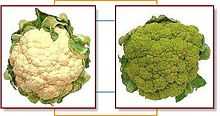Broccoflower
| Broccoflower | |
|---|---|
 Green cauliflower | |
| Details | |
| Species | Brassica oleracea |
| Cultivar group | Botrytis cultivar group |
Broccoflower refers to either of two edible plants of the species Brassica oleracea with light green heads. The edible portion is the immature flower head (inflorescence) of the plant.
There are two forms of Brassica oleracea that may be referred to as broccoflower, both of which are considered cultivars of cauliflower (Brassica oleracea var. botrytis) because they have inflorescence meristems rather than flower buds when harvested.[1] One is shaped like regular cauliflower, the other has a spiky appearance. They share a curd color that is a similar hue to that of broccoli.
Green cauliflower

The first form of broccoflower has the physical attributes of a white cauliflower, but the curd color is lime-green. There are several cultivars of green cauliflower on the market, with the first release being 'Green Ball' with parentage of both broccoli and cauliflower.[2] The California firm, Tanimura & Antle, trademarked the word "Broccoflower" for the green cauliflower they market.[3]
Romanesco broccoli

The second form is Romanesco broccoli, which is characterised by the striking and unusual fractal patterns of its flower head. It has a yellow or vibrant green curd color.
Broccoli and cauliflower are closely related and fully cross compatible. The cross is easily made by hand pollination or natural pollinators.[4] Some crosses within and between these types require embryo culture after the initial cross. A full range of intermediate types can be produced in later generations of such a cross, of which green-curded cauliflower is one.
Broccoflowers are generally considered to have a milder and slightly sweeter flavor than their close cabbage-family relatives.
Nutritional information
Like other members of Brassica oleracea, broccoflower is highly nutritious. One cup of broccoflower florets provides 20 calories, nearly two grams of protein, four grams of carbohydrates, two grams of fiber and is an excellent source of vitamin C.[5]
Green cauliflower is higher in protein, at 2.95%, than either white cauliflower, 1.92%, or broccoli, 2.82%.[6]
References
| Wikimedia Commons has media related to Romanesco. |
- ↑ Malatesta, M., Davey, J.C. (1994). "Cultivar identification within broccoli, Brassica oleracea L. var. italica Plenck and cauliflower, Brassica oleracea var. botrytis L.". Acta Horticulturae 407: ISHS Brassica Symposium - IX Crucifer Genetics Workshop.
- ↑ Honma, S., Heech, O. (1971), Green Ball: A New Type of Cauliflower, Michigan State University, Agricultural Experiment Station
- ↑ "Broccoflower brand green cauliflower from Tanimura & Antle". Retrieved 2011-09-29.
- ↑ Watts, LE (1968). "Natural cross-pollination and the identification of hybrids between botanical varieties of Brassica oleracea". Euphytica 17: 74–80.
- ↑ "Broccoflower at Truestar health encyclopedia". 2007. Retrieved 2007-08-15.
- ↑ "USDA National Nutrient Database for Standard Reference".